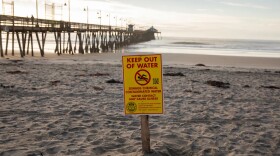Climate experts say a strong La Niña means a dry winter for Southern California. Water supply should be fine, but fire danger could increase next year.
Despite rain in October and in the weekend forecast, it looks like dry times for San Diego this winter.
Researchers say a strong La Niña means below normal rainfall for Southern California and a wet fall and dry spring for Northern California.
La Niña is defined as cooler than normal sea-surface temperatures in the central and eastern tropical Pacific Ocean that impact global weather patterns. La Niña conditions happen every few years and can last as long as two years.
That's what University of Colorado researcher Klaus Wolter is forecasting.
"I believe that the odds are much enhanced that we have a La Niña that goes on and on rather than disappear again," said Wolter.
Wolter said he’s not concerned about water supply this year. But if La Niña continues for a second year, it could impact future supplies.
But he is especially worried about fire.
“A dry winter for Southern California would make for dangerous fire conditions in early spring,” said Wolter.
While it may be a dry winter, Jeanine Jones, Interstate Resources Manager with the California Department of Water Resources, said the water supply is looking good for 2011.
“Above-average rain last year means most reservoir supplies are looking good for 2011,” said Jones. “Really only a couple of reservoirs are significantly below normal, so, thanks to last year’s precipitation, we were able to catch up on storage.”
Scripps Institution of Oceanography researcher Dan Cayan said the strong La Niña means chances of heavy rain events are “slim” this winter.
The three spoke at a California Department of Water Resources workshop designed to let water managers know what the prospects are for water supply conditions this winter.






